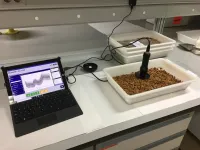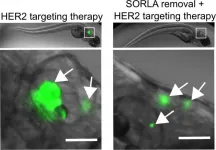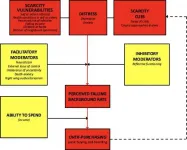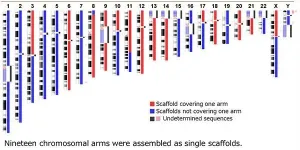New technology to detect bitter almonds in real time
2021-01-29
(Press-News.org) Who hasn't at some point been chewing on an almond and tasted an unpleasant and unexpected aftertaste that has nothing to do with the taste we are used to from one of the most consumed nuts in the world? The culprit has a name: amygdalin, a diglucoside that, when in contact with enzymes present in saliva, breaks down into glucose, benzaldehyde (the cause of the bitter taste) and hydrogen cyanide.
To reduce this unpleasant 'surprise', the Farming Systems Engineering (AGR-128) and Food Technology (AGR-193) research groups at the University of Cordoba's School of Agricultural and Forestry Engineering, with collaboration from the Andalusian Institute of Agricultural Research and Training's Alameda del Obispo Center, developed method that can predict levels of the abovementioned amygdalin present in the nuts analyzed both with and without shells, as well as correctly classify sweet almonds and bitter ones on an industrial scale, something that has only been done with shelled nuts, individual kernels or ground nuts to date.
The new system uses portable equipment based on NIRS technology -Near Infrared Spectroscopy- which can analyze large amounts of a product in situ in real time, without having to go into a lab. This technological application is "of great interest to the farming sector", explains Professor Dolores Pérez Marín, since almond bitterness in the wild can be helpful to prevent predators from ingesting the seeds of certain varieties, but on an industrial scale it offers no advantages and many disadvantages: an unpleasant taste, product devaluation and potential problems with food safety if consumption of bitter nuts occurs on a large scale.
Technically, the NIRS sensors use a beam of light that, when interacting with organic matter, returns a unique signal (spectrum) for each product sample, as in an unmistakable digital print that provides information and allows us to define the sample. In this case, as explained by doctoral student and first author of the research paper, Miguel Vega Castellote, the portable sensors, "whose signal along with the reference values allow for the development of prediction models", are able to analyze different parameters by "scanning" the product quickly and noninvasively, as in without modifying it.
Food fraud
Using NIRS technology, in which the research team has vast experience with an array of food products, is especially useful in the early detection of possible fraud and in food authentication. Therefore, the team has initiated another research project aimed at detecting batches of sweet almonds adulterated with bitter ones and in which almost 90% of the fraudulent items were identified. The system tested in this research, explains Professor María Teresa Sánchez Pineda de las Infantas, another author of the paper "could be implemented at any point in the value chain, including upon reception, during processing and shipping, and could be used as a fast and affordable anti-fraud early warning method".
INFORMATION:
[Attachments] See images for this press release:

ELSE PRESS RELEASES FROM THIS DATE:
2021-01-29
SORLA is a protein trafficking receptor that has been mainly studied in neurons, but it also plays a role in cancer cells. Professor Johanna Ivaska's research group at Turku Bioscience observed that SORLA functionally contributes to the most reported therapy-resistant mechanism by which the cell-surface receptor HER3 counteracts HER2 targeting therapy in HER2-positive cancers. Removing SORLA from cancer cells sensitized anti-HER2 resistant breast cancer brain metastasis to targeted therapy.
HER2 protein is a strong driver of tumor growth. HER2 amplification occurs ...
2021-01-29
High-intensity tropical cyclones have been moving closer to coasts over the past 40 years, potentially causing more destruction than before.
The trend of tropical cyclones - commonly known as hurricanes or typhoons - increasingly moving towards coasts over the past 40 years appears to be driven by a westward shift in their tracks, say the study's authors from Imperial College London.
While the underlying mechanisms are not clear, the team say it could be connected to changes in tropical atmospheric patterns possibly caused by climate change. The research is published today in Science.
Globally, 80 to 100 cyclones develop over tropical oceans each year, impacting regions in the Pacific, ...
2021-01-29
New research by Mimi E. Lam (University of Bergen) just published in Humanities and Social Sciences Communications identifies and explores the impacts of salient viral or COVID-19 behavioural identities that are emerging.
"These emergent COVID-19 behavioural identities are being hijacked by existing social and political identities to politicize the pandemic and heighten racism, discrimination, and conflict," says Lam. She continues: "the COVID-19 pandemic reminds us that we are not immune to each other. To unite in our fight against the pandemic, it is important to recognize the basic dignity of all and value the human diversity currently dividing us."
"Only ...
2021-01-29
Drawing on animal-foraging theory, a new model predicts psychological factors that may lead to panic buying during times of crisis. The model is largely supported by real-world data from the COVID-19 pandemic. Richard Bentall of the University of Sheffield, England, and colleagues presented these findings in the open-access journal PLOS ONE on January 27.
In the early stages of the pandemic, consumers in several countries around the world engaged in "panic buying" of household items, causing temporary shortages of toilet rolls and other products. Such behavior is typical during times of crisis, but few studies have examined the psychology of crisis-driven over-purchasing.
To better understand this phenomenon, Bentall and colleagues turned to animal-foraging ...
2021-01-29
As one of the most experienced archaeologists studying California's Native Americans, Lynn Gamble(link is external) knew the Chumash Indians had been using shell beads as money for at least 800 years.
But an exhaustive review(link is external) of some of the shell bead record led the UC Santa Barbara professor emerita of anthropology to an astonishing conclusion: The hunter-gatherers centered on the Southcentral Coast of Santa Barbara were using highly worked shells as currency as long as 2,000 years ago.
"If the Chumash were using beads as money 2,000 years ago," Gamble said, "this changes our thinking of hunter-gatherers and sociopolitical and economic complexity. This may be the first example of the use of money anywhere in the ...
2021-01-29
As part of standard patient protocol, doctors inform women of the risks of pregnancy. But there is one exception to this standard: stillbirth.
University of Arkansas law professor Jill Wieber Lens argues that women have a right to know of the risk of stillbirth, and, consistent with the evolution of informed consent law, this right should be enforceable through a medical malpractice tort claim.
Stillbirth, or pregnancy loss after 20 weeks but before birth, is not uncommon. Annually, 26,000 U.S. women give birth to a stillborn baby, or roughly one out every 160 pregnancies. The United States' stillbirth rate ...
2021-01-29
COLLEGE PARK, Md.--The amount of methane released into the atmosphere as a result of coal mining is likely much higher than previously calculated, according to research presented at the annual meeting of the American Geophysical Union recently.
The study estimates that methane emissions from coal mines are approximately 50 percent higher than previously estimated. The research was done by a team at the U.S. Department of Energy's Pacific Northwest National Laboratory, the U.S. Environmental Protection Agency and others.
The higher estimate is due mainly to two factors: methane that continues to be emitted from thousands of abandoned mines and the higher methane content in coal seams that are ever deeper, according to chief ...
2021-01-29
The Japanese now have their own reference genome thanks to researchers at Tohoku University who completed and released the first Japanese reference genome (JG1).
Their study was published in the journal Nature Communications on January 11, 2021.
"JG1 can aid with the clinical sequence analysis of Japanese individuals with rare diseases as it eliminates the genomic differences from the international reference genome," said Jun Takayama, co-author of the study.
Back in 2003, the Human Genome Project, through a gargantuan global effort, cracked the code of life and mapped all the genes of the human genome.
Since then, more accurate versions of the human reference genome have ...
2021-01-29
The researchers of the Institute for Atmospheric and Earth system research at the University of Helsinki have investigated how atmospheric particles are formed in the Arctic. Until recent studies, the molecular processes of particle formation in the high Arctic remained a mystery.
During their expeditions to the Arctic, the scientists collected measurements for 12 months in total. The results of the extensive research project were recently published in the Geophysical Research Letters journal.
The researchers discovered that atmospheric vapors, particles, and cloud formation have clear differences within various Arctic environments. The study clarifies how Arctic warming and sea ice loss strengthens processes where different vapors are emitted to the atmosphere. The ...
2021-01-29
The Covid-19 pandemic has made home offices, virtual meetings and remote learning the norm, and it is likely here to stay. But are people paying attention in online meetings? Are students paying attention in virtual classrooms? Researchers Jens Madsen and Lucas C. Parra from City College of New York, demonstrate how eye tracking can be used to measure the level of attention online using standard web cameras, without the need to transfer any data from peoples computers, thus preserving privacy. In a paper entitled "Synchronized eye movements predict test scores in online video education," published in the Proceedings of the National Academy of Sciences, they show that just ...
LAST 30 PRESS RELEASES:
[Press-News.org] New technology to detect bitter almonds in real time






